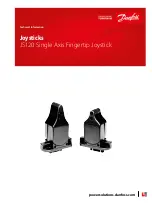
14.4.4
CV Amplitude and Rate Limits
The PID block does not send the calculated Output directly to CV. Both PID algorithms
can impose amplitude and rate of change limits on the output Control Variable. If the
Minimum Slew Time (word 12 of the reference array) is non-zero, the rate of change
(slew rate) limit is determined by dividing the maximum CV value (32,000) by the
Minimum Slew Time. For example, if the Minimum Slew Time is 100 seconds, the rate
limit will be 320 CV counts per second. If the solution interval was 50 milliseconds, the
new CV output cannot change more than 320*50/1000 or 16 CV counts from the previous
CV output.
The CV output is then compared to the CV Upper Clamp and CV Lower Clamp values
(words 10 and 11 of the reference array). If CV is outside either limit, the CV output is
clamped to the appropriate limit value. When the CV output is modified to impose either
slew rate or amplitude limits (or both) the stored integral term would normally
accumulate a large value over time. This phenomenon is known as
reset windup
. Reset
windup introduces errors in CV after the PID output no longer needs to be limited. For
example, windup would prevent the CV output from moving off a clamp value
immediately.
There are two optional methods for preventing reset windup. If the Anti-resetwindup
Action bit (bit 4) of Config Word (word 13 of the reference array) is zero (the default), the
integral term is adjusted at each PID solution to match the error input and limited CV
output exactly. When PV changes while CV is clamped, or when CV is both rate and
amplitude limited in a particular PID solution, this option assures that a smooth transition
will always occur after CV is no longer limited.
If the Anti-reset-windup Action bit of Config Word is set, then the integral term stored on
the previous PID solution is simply retained as long as CV is limited. This option was
added to assure compatibility with existing PID applications when the default action
described above was introduced. This option is not recommended for new applications.
Finally, the PID block checks the Output Polarity (bit 2 of the Config Word ) and changes
the sign of the output if the bit is 1.
CV = Clamped PID Output if Output Polarity bit set, or
Clamped PID Output if Output Polarity bit cleared.
If the block is in Automatic mode, the final CV is placed in the Manual Command (word
14 of the reference array). If the block is in Manual mode, the PID equation is skipped
because CV is set by the Manual Command, but the slew rate and amplitude limits are
still checked. This assures that the Manual Command cannot change the output above the
CV Upper Clamp or below the CV Lower Clamp, and the output cannot change faster
than allowed by the Minimum Slew Time.
286
GFK-1503E
VersaMax PLC User Manual
For public disclosure
Summary of Contents for VersaMax PLC
Page 16: ...Notes 16 GFK 1503E VersaMax PLC User Manual For public disclosure ...
Page 38: ...Notes 38 GFK 1503E VersaMax PLC User Manual For public disclosure ...
Page 50: ...Notes 50 GFK 1503E VersaMax PLC User Manual For public disclosure ...
Page 92: ...Notes 92 GFK 1503E VersaMax PLC User Manual For public disclosure ...
Page 112: ...Notes 112 GFK 1503E VersaMax PLC User Manual For public disclosure ...
Page 224: ...Notes 224 GFK 1503E VersaMax PLC User Manual For public disclosure ...
Page 292: ...Notes 292 GFK 1503E VersaMax PLC User Manual For public disclosure ...
Page 316: ...Notes 316 GFK 1503E VersaMax PLC User Manual For public disclosure ...
Page 317: ......
















































